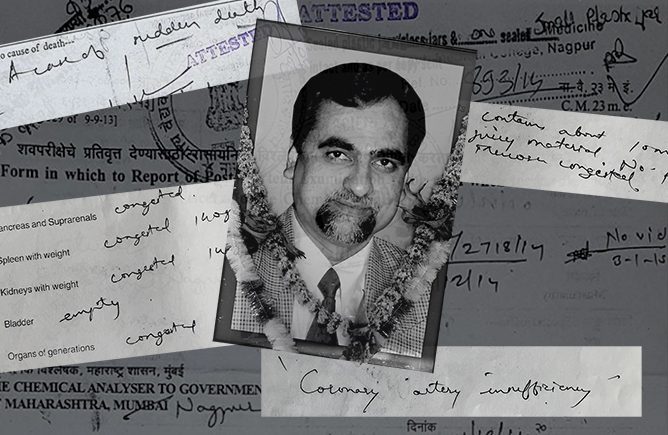A statement to the police by a room service staffer at Ravi Bhawan in Nagpur, who was on duty when the judge BH Loya is said to have checked in to the guest house, directly contradicts the accounts of two judges who accompanied him from Mumbai. These accounts form part of the basis for the Supreme Court judgment that upheld the Maharashtra state government’s claim that Loya died a natural death.
Two judges, Shrikant Kulkarni and SM Modak, said that they travelled with Loya in an overnight train from Mumbai to Nagpur. Both judges further stated that on arriving at Nagpur on the morning of 30 November, they had gone to Ravi Bhawan—the government guest house where Loya is said to have been staying at the time of his death. But according to a statement given by Tilak Narayan, then a member of the room service staff at Ravi Bhawan, to the Nagpur police, no judge came to Ravi Bhawan while he was on duty, till the afternoon on that day.
The statement, given to the police on 23 November 2017, is one of several documents attached with an application filed by Satish Uke, a lawyer and activist, before a Nagpur district court, seeking directions to Nagpur’s Ajni police station to investigate Loya’s death. Not only does it cast strong doubt on the veracity of the judges’ statements, it also suggests that the Maharashtra government deliberately suppressed this vital information from the Supreme Court.
The official account of Loya’s death relies on the statements of four judges—Kulkarni, Modak, VC Barde and Rupesh Rathi—who claim to have been with the late judge at the time of his death, and which was submitted to Maharashtra’s State Intelligence Department, or SID. The SID submitted its “discreet inquiry” report to the Maharashtra government, which was later placed before the Supreme Court during the hearings on petitions seeking an independent inquiry into Loya’s death. A three-judge bench—comprising then chief justice Dipak Misra, AM Khanwilkar and DY Chandrachud—upheld the SID’s conclusion that Loya died of a heart attack, primarily relying on the report and the judges’ statements. At one point, the court observed, “There is no reason for this Court to doubt the statements of Judge Kulkarni, and Judge SM Modak.”
Narayan gave his statement at the Sadar police station, on the same day the state government ordered the discreet inquiry, and three days after The Caravan broke the story on the suspicious circumstances surrounding Loya’s death. Narayan stated that five suites were booked for 30 November 2014 by the registrar of the Bombay High Court—the suites 2, 3, 5, 10 and 20. “On that day, my duty was during the morning hours and workers of the high court were present,” Narayan said. “During my duty hours, I gave them the keys … in accordance with the reservations made. No officer had shown up for a room during my duty hours. Employees of the high court had come for assistance to the officers who were to stay in the mentioned suites in Ravi Bhavan. After I finished my duty, I went home in the afternoon.” This statement, collected by the Nagpur police, was available with the state of Maharashtra and yet did not form part of the report placed before the Supreme Court.
Uke obtained Narayan’s statement through right-to-information applications filed in October this year. Uke’s application seeking an investigation into Loya’s death cites several grounds in addition to Tilak’s statement—including documents that suggest records at Ravi Bhawan were manipulated, and that reveal that Loya was travelling to Nagpur “for government work,” and not a wedding, as officially claimed. The case is listed for its first hearing on 12 November.
Narayan’s statement directly contradicts the accounts by Kulkarni and Modak. Modak notes in his statement, “We reached Nagpur in the morning of 30/11/2014 … From station we went to Ravi Bhuvan.” Kulkarni writes that the three judges “reached Nagpur in the morning of 30th November, 2014” and then “went to Ravi Bhavan Government Guest House where V.I.P. Suite was booked.” Despite the stark contradiction between Narayan’s statement to the police and those by Modak and Kulkarni, the former was not included in the SID’s report. The Supreme Court judgment, written by Chandrachud, notes that the judges’ statements have “a ring of truth” and states, “We must lean in favour of the version of the four judicial officers unless strong and indisputable circumstances are shown to doubt their credibility.” Six months after the judgment was pronounced, Modak was elevated to the Bombay High Court.
The fact that an employee of Ravi Bhawan had stated before the police on 23 November 2017, collected the day before the statements of Modak and Kulkarni, that Loya did not arrive at the guest house till the afternoon would have been crucial information for the Supreme Court’s consideration—all the more so as it contradicts statements by the judges. It now offers strong grounds for doubting the credibility of the versions given by the judicial officers to the court. Moreover, the Contempt of Courts Act, 1971 includes within its definition of criminal contempt, “any other act whatsoever which … prejudices, or interferes or tends to interfere with, the due course of any judicial proceeding.” On the face of it, it would appear that the state government, by omitting Narayan’s statement from its submission to the Supreme Court, could be liable for criminal contempt.

Leave a Reply